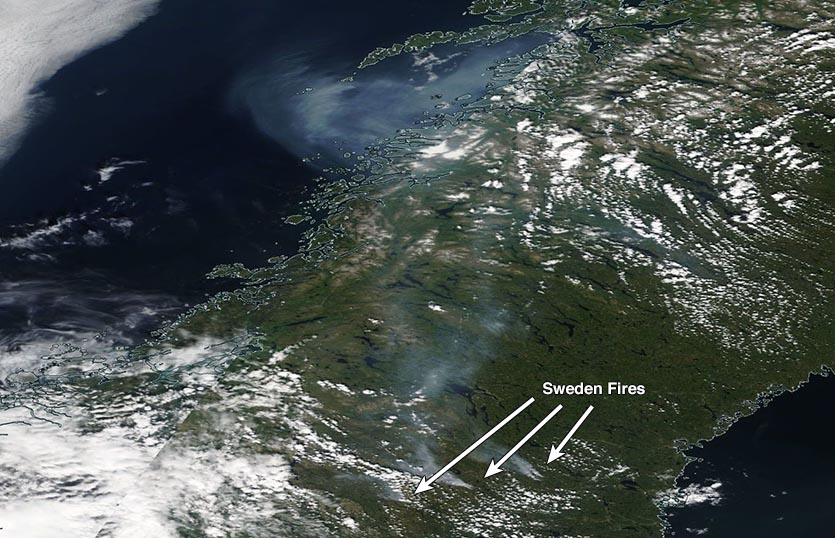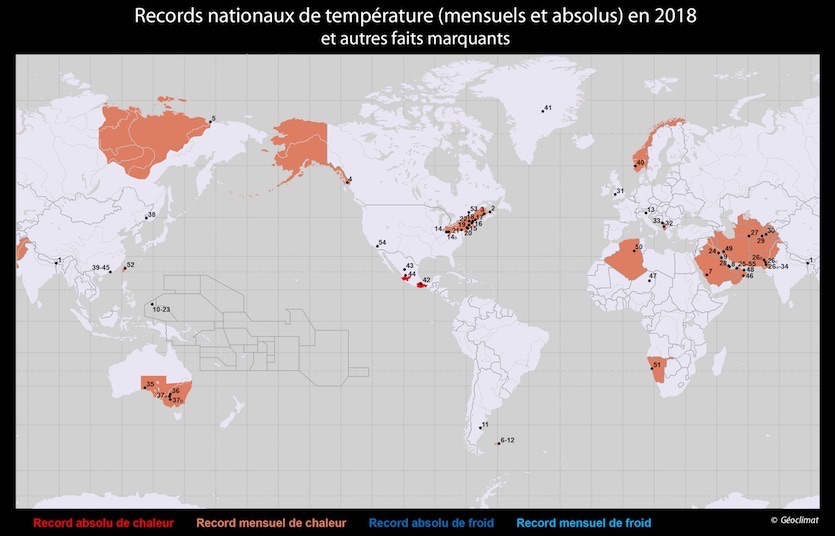| Above: Forest fires burn near Ljusdal, Sweden, on Tuesday, July 17, 2018. Image credit: Maja Suslin/AFP/Getty Images). |
Temperatures soared into the nineties Fahrenheit north of the Arctic Circle on Tuesday and Wednesday, as 2018’s parade of exceptional heat continued marching across the Northern Hemisphere. This week has been northern Scandinavia’s turn under the sizzling klieg lights, including Lapland (Sápmi), the region of northern Scandinavia famed for its reindeer and often associated with Christmas. In contrast to that wintry reputation, Sweden is now grappling with an onslaught of wildfires unprecedented in modern times, as reported by weather.com.
Here’s a sampling of the preliminary all-time highs set in Scandinavia on Tuesday.
FINLAND
Kilpisjärvi: 28.3°C (82.5°F)
Kittila Pokka: 30.2°C (86.4°F)
Salla: 31.5 (88.7°F)
Sodankylä: 31.8°C (89.2°F)
Rovaniemi (capital of the Finnish province of Lapland): 32.2°C (90.0°F)
NORWAY
Sihcajavri: 29.2°C (84.6°F)
Namsskogan: 32.6°C (90.7°F)
Mo I Rana: 32.6°C (90.7°F)
SWEDEN
Katterjak Airport: 28.3°C (82.5°F)
Kvikkjokk: 32.5°C (90.5°F)
Located at an altitude of 1100 meters (3500 feet), Finland's Tarfala Research Station is the coldest long-term reporting site in Lapland, according to weather records expert Maximiliano Herrera. The station hit 23.1°C (73.6°F) on Tuesday, smashing the all-time record of 21.4°C (70.5°F). The overnight low Monday night at Tarfala was a strikingly mild 13.3°C (55.6°F).
More records were smashed on Wednesday, including 33.4°C (92.1°F) at Kevo, Finland—the hottest temperature in reliable records for all of the province of Lapland in Finland, according to Herrera. Other all-time highs in the preliminary list for Wednesday:
Bodo: 30.4°C (86.7°F)
Stokmarknes: 31.6°C (88.9°F)
Evenes: 32.2°C (90.0°F)
Alta: 33.0°C (91.4°F)
Bardufoss: 33.5°C (92.3°F)
 |
Figure 1. Smoke covers portions of Norway and Sweden on July 17, 2018, due to fires burning in Sweden. All-time record heat in Scandanavia over the past few days has led to Sweden's most serious wildfire situation of modern times, according to the nation's Civil Contingencies Agency (see Wednesday's weather.com write-up on the situation). Image credit: NASA. |
A tropical night in the mountains of Lapland
At the Makkaur, Norway lighthouse, located at 70.7°N--hundreds of miles inside the Arctic Circle--the temperature did not drop below 25.2°C (77.4°F) the night of July 18 - 19. According to Herrera and weather records expert Jérôme Reynaud, this destroyed the world record of highest minimum temperature for the Arctic, and is the all-time third highest minimum temperature recorded anywhere in Scandinavia. It is also the highest minimum temperature ever recorded in northern Norway (previous record for northern Norway: 24.7 °C on July 1, 1972 at Grøtøy), and for northern Scandinavia as a whole. Several other stations in Norway also set unfathomable minimum temperature marks on Thursday morning, including 20.5°C (68.9°F) at Lyngen Gjerdvassbu, Norway at 69.55°N at an elevation of 710m (1583 feet).
The insanely warm minimum temperatures are being made possible by ridiculously warm ocean temperatures in the Baltic Sea, which were more than 8°C (14°F) above average on July 18, in the northern Gulf of Bothnia between Finland and Sweden.
Here are the top three all-time warm-minimum temperatures on record in Scandinavia:
25.8°C (78.4°F), Alstadhaug, Norway, 5 July 1937, at a latitude of 63.7°N.
25.5 °C (77.9°F), Halden-Langbryggen, Norway, 9 July 1933.
25.2°C (77.4°F), Makkaur, Norway, 19 July, 2018
And these are the all-time warm minimum records by nation:
Norway highest minimum: 25.8°C, Alstadhaug, 5 July 1937
Sweden highest minimum: 23.7°C, Kullen, 10 August 1975
Finland highest minimum: 24.2°C, Kotka-Haapasaari, 1 August 2003
Has it ever hit 100°F in the Arctic?
The hottest location in the Scandinavian Arctic on Tuesday, according to Michael Theusner (Klimahaus), was Kevo (latitude 69.75°N), with a high of 32.7°F (91.0°F). If you’re wondering whether any place in or very near the Arctic has ever broken 100°F, the answer is yes—but just barely. Back on July 23, 2010, the community of Ust Moma, Russia (latitude 66.27°N, or about eight miles south of the Arctic Circle), got up to 37.8°C (100.04°F), according to weather records expert Maximiliano Herrera. That’s the warmest reliable temperature on record at or north of that latitude, he says, although there’s an equal reading of questionable veracity in the books from Prospect Creek, Alaska, on June 27, 1915. The highest reliable reading north of latitude 67°N appears to be 37.3°C (99.1°F) at Verkhoyansk, Russia (67°33'N), on July 25, 1988.
The heat across Scandinavia is being driven by a large, strong upper-level high parked over the region. The persistent high pressure has also fed unusually warm, dry conditions across the British Islands, where several all-time heat records were broken just a few days ago (see last week’s roundup from WU weather historian Chris Burt). Parts of southern England have gone more than a month without a drop of measurable rain, noted the Guardian, which also pointed out that the same type of upper-level blocking pattern can produce bitter cold across the region in winter. As this upper high builds westward, and a zone of warm maritime air approaches from the Atlantic, London could see a solid week of highs topping 80°F from Thursday onward.
After a less hot interlude over the last couple of days, forecast models are suggesting temperatures creeping up again into next week, along with increasing humidity pic.twitter.com/UWaLTM4x47
— Met Office (@metoffice) July 18, 2018
After a less hot interlude over the last couple of days, forecast models are suggesting temperatures creeping up again into next week, along with increasing humidity pic.twitter.com/UWaLTM4x47
— Met Office (@metoffice) July 18, 2018
Figure 2. Children play in the water at a park in Tokyo, Monday, July 16, 2018. Several locations in Japan have set all-time high temperature records this month. Image credit: AP Photo/Koji Sasahara. |
Heat wave rolls onward in East Asia
Extreme heat has gripped parts of East Asia, including Japan and Korea, since last weekend, with several more days of intense heat on tap. The heat wave is being blamed for at least 14 heat-related deaths and thousands of heat-stroke hospitalizations. On Thursday, July 19, Kyoto tied its all-time high temperature for any month, 39.8°C (103.6°F), previously set on August 8, 1994. Kyoto has also beaten its previous all-time high for July (38.3°C/101.0°F from July 26, 2014) on five of the past six days:
38.5°C (101.3°F) on Saturday, July 14
38.7°C (101.7°F) on Sunday, July 15
38.5°C (101.3°F) on Monday, July 16
39.1°C (102.4°F) on Wednesday, July 18
39.8°C (103.6°F) on Thursday, July 19
Weather records in Kyoto extend back to 1881.
A number of all-time records set on Monday, July 16, in Japan, although most of the stations have periods of record dating back only to 1976.
Okunikko (Tochigi prefecture): 30.4°C (86.7°F), previous record 30.2C on July 16, 1946 (data since 1944)
Ikari (Tochigi prefecture): 33.9°C (93.0°F), previous record 33.6C on August 7, 1994 (data since 1977)
Otawara (Tochigi prefecture): 37.1°C (98.8°F), previous record 36.8C on August 6, 2015 (data since 1976)
Ikuno (Hyogo prefecture): 37.5°C (99.5°F), previous record 37.4C on August 8, 1994 (data since 1978)
Miyoshi (Hiroshima prefecture): 37.9°C (100.2°F), previous record 37.4C on the day before and 37.2C on August 2, 2001 (data since 1978)
Akana (Shimane prefecture): 35.1°C (95.2°F), previous record 35.0C on August 6, 1994 (data since 1978)
 |
| Figure 3. Dozens of nations and states around the globe have recorded monthly or all-time record high temperatures in 2018 thus far. Each location and record is detailed in the annotated version of this graphic. Image credit: Jérôme Reynaud, Géoclimat. |
Rocky Mountain highs: Record-breaking strings of hot days
Parts of Colorado have seen an unprecented number of days hitting at least 90°F for the year to date. Up through Monday, July 16, Denver reported 33 days in the 90s, which beats the old year-to-date record of 31 such days, set in 2012. Denver’s weather records go all the way back to 1872. In Pueblo, where records go back to 1888, a total of 49 days have hit the 90°F mark so far, compared to the previous year-to-date record of 42, set in 1974. We have a long way to go before Pueblo could reach the full-year record total of 90 days hitting at least 90°F, which was set in 2000. However, the city is predicted to reach 90°F every day for at least the next week, and some of Pueblo’s hottest weather can occur in August, after the peak of the midsummer monsoon.
Even the state of Texas—where summer temperatures often climb above 100°F—is feeling the heat. Readings in the Dallas-Fort Worth area hit 104°F on Tuesday and 106°F on Wednesday. The DFW metroplex could reach or exceed 105°F each day into early next week, along with low temperatures possibly failing to dip below 80°F. The longest streak of highs on record of at least 105°F in Dallas-Fort Worth occurred during the infamous heat wave of 1980. That year produced 11 consecutive days of 105°F heat—from July 8 to 18—and an incredible 28 days across the summer as a whole. The forecast calls for the heat wave to peak on Friday, with a high temperature of 109°F. There has been only one July day since 1980 to record a temperature that warm in the city—a 110°F reading on July 12, 1998.
Waco, Texas recorded a high temperature of 108°F on Wednesday. This breaks the previous daily record of 106°F set in both 2006 and 1925, and is the hottest temperature recorded in Waco since August 28, 2011 (109°F).
Thanks to Maximilliano Herrera, Etienne Kapikian, Jerome Reynaud, Michael Theusner and Jeff Masters for contributing data to this post.




